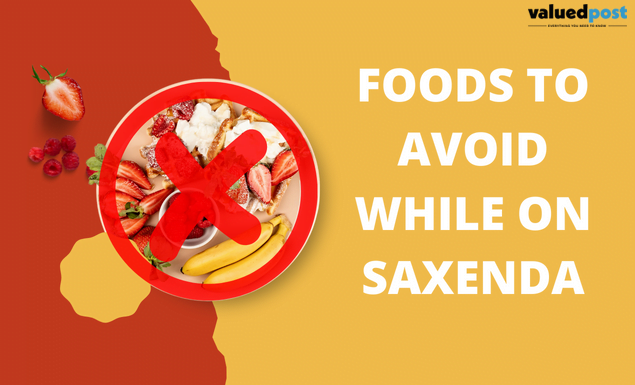While using Saxenda, there are no particular Foods to avoid while on saxenda; nonetheless, Dr’s advice is that you consume fewer calories and engage in more physical exercise.
Saxenda is an injectable drug administered once daily to treat patients with other weight-related medical conditions who are overweight or obese. It is a member of the drug family known as glucagon-like peptide-1 (GLP-1) receptor agonists.
What is Saxenda?
Produced by Novo Nordisk, Saxenda is an FDA-approved prescription injectable medication with the active component liraglutide. It aids in weight loss and weight maintenance.
Obesity and other chronic conditions typically call for long-term care. Your doctor will work with you to develop a detailed strategy that is tailored to your weight-management objectives.
For the treatment of high cholesterol or high blood pressure, Saxenda is not authorized.
How does Saxenda work?
An FDA-approved glucagon-like peptide-1 (GLP-1) drug called Saxenda used for overweight or obese persons. Saxenda can assist patients with weight reduction and long-term weight management when used in conjunction with appropriate dietary changes and regular exercise. The medication slows the rate at which food exits your stomach by mimicking the incretin hormones that your body naturally generates. For those with diabetes or reduced glucose tolerance, it can lower blood sugar levels.
Foods to avoid while on saxenda

It’s crucial to maintain a healthy, balanced diet while using Wegovy or Saxenda if you want to be successful at reducing weight. Foods to avoid while on saxenda:
- Foods high in sugar, such as cookies, cake, and chocolate;
- Foods that are fried, saturated fat-rich, and processed;
- Sodas and other carbonated sweet beverages;
- Unhealthy restaurant food or fast food.
Foods to include while on Saxenda

When using Saxenda or Wegovy, it’s crucial to adhere to the dietary advice given to you by your weight reduction physician. Patients typically have a daily calorie allowance of between 2,000 and 2,500. Despite having 150 calories, would something make you feel satisfied for a long period of time? Is a valuable vitamin or nutrient being provided? When developing a nutrition plan, these issues should be taken into account.
Protein-rich foods: Our health depends on getting adequate protein in our meals. Foods high in protein help us feel fuller longer, which supports healthy body weight in addition to supporting practically every bodily function.
Vitamin-rich veggies and fruits: Fruits and vegetables are naturally low in fat and packed with nutrients. To add to your diet, pick a range of foods that are high in vitamins.
Whole grains: Whole grains are packed with fiber and complex carbohydrates that keep you fuller for longer while preventing blood sugar spikes. Make sure it has 3 grams or more of fiber per serving in addition to other necessary nutrients by checking the label.
Most common saxenda side effects in adults.
- Nausea
- Diarrhea
- Vomiting
- Constipation
- Dizziness
- Headache
- Fatigue
- Low blood pressure
- Reaction on the site of injection
- Stomach pain
- Change in enzyme levels in your blood
Saxenda’s most frequent adverse effect, nausea, is known to subside in most patients over time as their bodies adjust to its use. Here are a few recommendations that may be helpful if you feel nausea while using this medication:
- consume bland, low-fat items like crackers, bread, and cereal.
- Foods to avoid while on saxenda that are dehydrating
- Eat smaller meals more often rather than bigger ones to avoid overeating (using smaller plates may help to reduce portion sizes)
- periodically sip water
- don’t go asleep after eating.
- Avert wearing restrictive clothes
- go outside to get some fresh air
Additionally, there are a number of less frequent yet dangerous adverse effects of Saxenda:
- greater possibility of thyroid cancer
- pancreatitis (inflammation of the pancreas)
- profound hypoglycemia (low blood sugar levels)
- higher heart rate
- kidney issues (kidney failure)
- issue with gallbladder
- anxiety
- insomnia
- severe allergy reactions
Taking Saxenda may also cause major adverse reactions, such as thyroid cancer and tumors. Call your doctor straight away or go to an emergency room if you develop any of these adverse effects or if you are allergic to Saxenda.
Who is eligible for Saxenda?
Saxenda is used to treat chronic obesity in adults with a body mass index (BMI) of 30 kg/m2 or more, as well as in obese children over the age of 12, in conjunction with a low-calorie diet and increased physical activity.
You Should avoid saxenda if:
- You’re under 18
- Allergic to any ingredients in saxenda
- Pregnant or planning
- If you have Multiple Endocrine Neoplasia syndrome type 2 or MTC, or if anybody in your family has ever experienced any of these conditions, please contact us (MEN 2).
Make sure before starting you inform your doctor about any previous or ongoing conditions, including:
- Use any medications that act as GLP-1 receptor agonists
- Have or have ever had any issues with your kidneys, liver, or pancreas?
- Have significant abdominal issues, such as gastroparesis, which causes your stomach to empty more slowly than usual, or if you have trouble digesting meals.
- Suicidal thoughts, sadness, or a history of any mental health conditions exist or have existed
- Either now breastfeed or want to do so.















